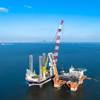In 1982, 2-D (two-dimensional) seismographic technology was the hot and newest technique being used to locate oil and gas. Geophysicists, along with drill rigs, geophones and computers, were traversing both land and water in the petroleum belt to locate what lay beneath the Earth's surface.
Typically, the offshore exploration using this technology would require chartering vessels, which were available near the proximity of the work site. Often, this entailed the use of fishing type vessels, which were designed for the harvest of commercial fisheries.
In South Louisiana, one such owner of this type of vessel was Ernie Geraci, (president-Shallow Draft Elevating Boats, Inc.) whose boat Princess Amanda was well known by the seismic crews for its speed and handling. Geraci had designed and built this vessel using hydraulics and technology to mechanize the harvesting process.
Consequently, Princess Amanda was constantly under charter by the seismic crews.
One day, while on a charter in Mobile Bay, the tides were running hard, the wind was blowing and performing the seismic drilling work in such conditions became unsafe and the work was halted. The weather was a huge determining factor in the area of productivity, as drilling work could only be performed when the vessel was held steady in calm seas.
This type of interruption was occurring more and more frequently, which prompted Geraci to start thinking of a vessel design more suitable for this type of drilling work.
Without a contract or financial backing, Geraci's entrepreneurial spirit kicked into high gear and he set about building the first prototype Shallow Draft Elevating Boat. His idea was to build a vessel that would be self propelled and provide a stable and safe platform over the water where crews could perform their drilling work regardless of the tides, wind and wave action.
This design would minimize the downtime the crews were experiencing.
Once Geraci completed construction of the vessel it was tested. Seismic crews mounted their drilling units and went to work. They were amazed at the stability the new vessel provided and the speed with which it placed itself into position - no more anchors, moorings or lashings.
Now they simply drove up to the location of the drill site and elevated the legs and got to work. This new vessel quickly became the vessel of choice in the offshore seismograph work and is now used all over the world today in that industry.
Geraci has spent the last 10 years improving the design of the vessel and incorporating modifications to make the vessel more productive. Currently, vessels are available in 35 x 15 ft. and 45 x 18 ft. models.
The Shallow Draft Elevating Boat is constructed of steel and features three elevating vertical legs, which elevate the hull out of the water, eliminating the effects of wind, waves and tides. Since it is self-propelled there is no need for costly tugboats or licensed captains, and with its simplistic design practically anyone can operate it.
The Detroit Diesel engine provides for the self-propulsion as well as the on-board hydraulics used to elevate the hull. For those environmentally concerned, the hull includes a tunnel drive design leaving the water bottoms virtually undisturbed.
Shallow water is not a problem; the vessel is designed to carry a deck load of 9,000 lbs. and draw a total of 18 in. of water with full maneuverability. The legs provide the capability of elevating the hull out of water as deep as 45 ft. to handle deeper river and channel applications.
If the waterways to the job site are not navigable, the Shallow Draft Elevating Boat may be the answer. The vessel is launched from practically any location and is mobile in extremely shallow depths.
The vessel has been designed to be transportable. It is delivered on a common flat bed trailer, shipped to the worksite, assembled and launched by the Shallow Draft Crew and made ready for the crew to go to work.
Questions of the vessel's durability have also been answered, as customers have used man lifts, generators, excavators, cranes, drilling rigs, sand blasting and painting equipment on the deck of this workhorse.
Featured videos

AI to the Rescue: Zelim’s ZOE to be Installed on Cruise Ship

Saltchuk Doubles Down on Workforce Development Investments
April 2025
 Read the Magazine
Read the Magazine

 Read the Magazine
Read the Magazine
This issue sponsored by:

Crowley Builds the Future Maritime & Logistics Workforce
Subscribe for
Maritime Reporter E-News
Maritime Reporter E-News is the maritime industry's largest circulation and most authoritative ENews Service, delivered to your Email five times per week









